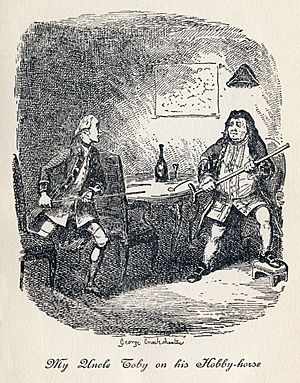Hobby horse polo facts for kids
| Characteristics | |
|---|---|
| Team members | 6 per side |
| Mixed-sex | Yes |
| Type | ball game, team sport, outdoor |
| Equipment | Ball, stick, hobby horse, sherry |
| Venue | Polo field (grass) |
| Presence | |
| Country or region | Germany |
| Olympic | No |
Hobby horse polo (called Steckenpferdpolo in German) is a super fun team sport. It's played while riding a toy hobby horse! It's a bit like regular polo, but with its own special twists. Imagine playing polo, but instead of a real horse, you have a stick horse between your legs.
How Hobby Horse Polo Started
Hobby horse polo began in 1998 in Heidelberg-Neuenheim, Germany. It started as a playful way to make fun of very expensive hobbies. These hobbies were often enjoyed by people in "polite society".
In 2002, the first official club was formed in Mannheim. Since then, it has become a popular sport. Many teams have started in different German cities. It has even been featured in the news!
Playing polo with hobby horses is actually an old idea. It has been described as a children's game in places where traditional polo is played. For example, a professor named Hugh van Skyhawk saw young boys playing it. They played it as part of a harvest festival in Hispar.
In 2013, the first hobby horse polo game in Switzerland was organized. It was held by a music group called Grütlihüüler Guggenmusik in Allenwinden.
Rules of the Game

The main goal of hobby horse polo is to score goals. You score by hitting a softball into the other team's goal. Goals are usually marked by bar stools. Sometimes, simple street hockey goals are used instead. Players use a long stick, like a croquet mallet, to hit the ball.
A full game has six periods, called chukkas. Each chukka lasts for 6 minutes. Each team can have up to six players. The number of players depends on the field size. The playing field must be at least 30 meters (about 98 feet) long. It also needs to be at least 15 meters (about 49 feet) wide.
A special rule called the 'last man' rule applies. This means any player can act as the goalkeeper. Players should wear cleated shoes and shin guards. This helps protect them from possible injuries. The mallets should be strong. Players often tape them to make sure the head doesn't fly off. It's important to hit the ball, not other players!
How a Game Starts
Each game begins with both teams lined up behind their own goals. The ball is placed in the middle of the field. The umpire shouts "Polo go!" Then, the teams gallop towards each other. Players hold their mallets in one hand. Their hobby horses must be held between their legs with the other hand. You are not allowed to kick the ball. You also cannot stop the ball with your foot.
Penalties and Swiss Rules
If a player commits a foul, they might get a penalty. This could be for not galloping or not listening to the umpires. In some games, the penalty is to drink a special non-alcoholic drink called Brottrunk. This drink must be consumed right away.
In Switzerland, the rules are a bit different. They are more like association football (soccer) rules. Fouls result in free hits or penalties, not special drinks. Riding boots are allowed in Swiss games. This is because of the history of the Swiss cavalry. However, spurs (sharp objects on boots) are strictly forbidden.
At tournaments in Düsseldorf, Germany, the winning team gets a special prize. Instead of a trophy, they receive a delicious cheesecake! This is a fun homage to the Indianapolis 500 race. At that race, the winner traditionally drinks milk from a milk bottle.

